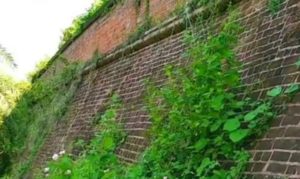Berhampur: The historical pentagon-shaped Potagada fort near the city, which was the witness to three foreign rulers, now stands ravaged by the time and saline breeze from nearby Bay of Bengal.
According to historians, the existing fort of Potagarh was constructed in 1768 under supervision of the first British resident officer of Ganjam, Edward Costford. It has five bastions and the plan is pentagon. Within the fort, there are office buildings, magazine, artillery, armoury, stores, custom houses etc.
The star-shaped fort is surrounded by a wide and deep moat. Its strongly built earthen rampart is about 15-ft high, 92-metre long and 19-metre wide.
Since the fort was built underground, it is not visible from a distance. Located on the confluence of river Rushikulya and the Bay of Bengal, it served as the first collectorate complex of Ganjam 253 years ago.

Potagarh is not a single fort, rather a cluster of forts, which throws light on history of Muslim and French rulers and their administrative procedures. It is believed that Muslim rulers had erected a fort at the site. In 1753, Monsieur De Bussy, a French commander, took control over Ganjam and functioned from Potagarh. In 1765, the French rule ended and Potagarh came under the British.
Inside the compound, there are residential buildings of three different architectural designs of the rulers. The first one, probably of Muhammadan or Kutabshahi origin, has been almost ruined.
Besides, there are two magazine houses and two passages on the eastern side of the compound wall opening to the river. One was probably used as a secret passage to escape into the sea and the other for the queen to go to the river to take bath.
The compound wall is encircled by a moat. The fort has two nicely designed doors, one is in the front side the other one is in the back side, close to the river.

Since it is a state protected monument, the state archaeology department has conserved some fallen parts of the fort in the campus. It has also cleared wild bushes and desilted the moat. Besides, it has provided power supply to the complex and laid a 2-km approach road from the National Highway 16.
But there has been no perceptible development of the fort which can serve as an architectural wonder of three historical styles and major attraction of the tourists. The plan of construction of a Panthanivas mooted a decade ago, a restaurant and a reading room with other basic facilities is moving on a snail’s pace.
The historians maintain that within the fort lie artifacts from medieval Orissa that can throw more light on the political, culture and social life of the time.
However, attracted by its designs and ambience on the confluence of river Rushikulya and Bay of Bengal, the students, scholars and history lovers visit the fort from time to time.


